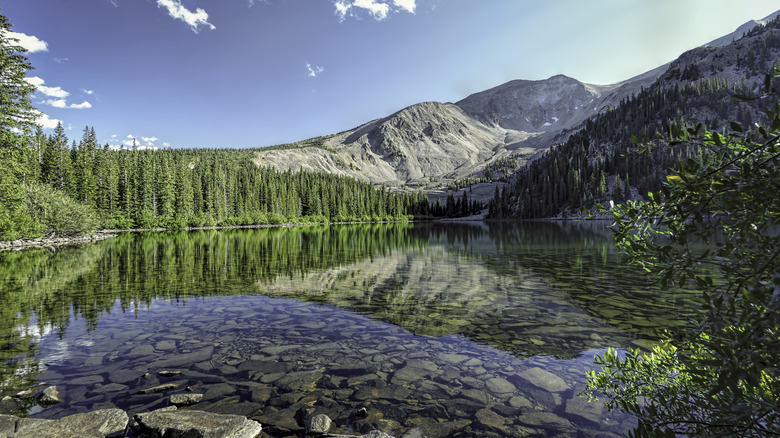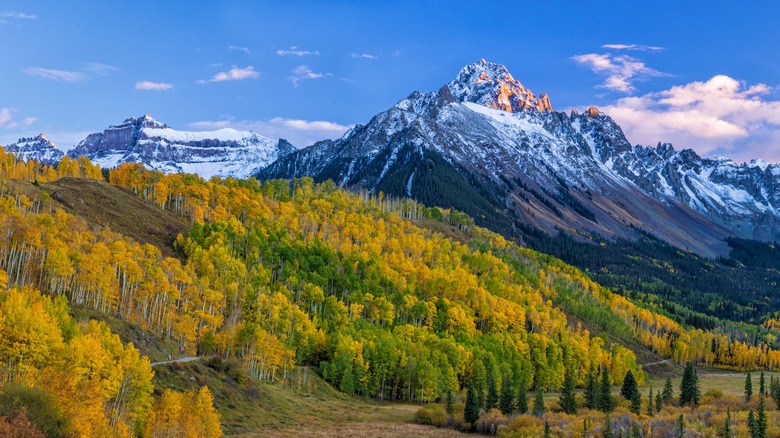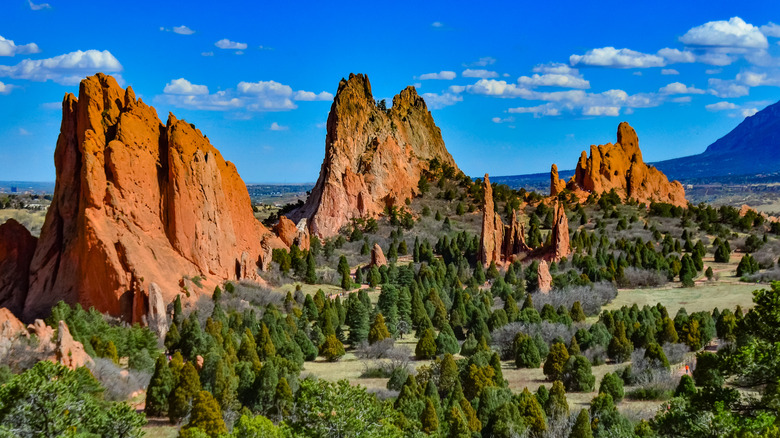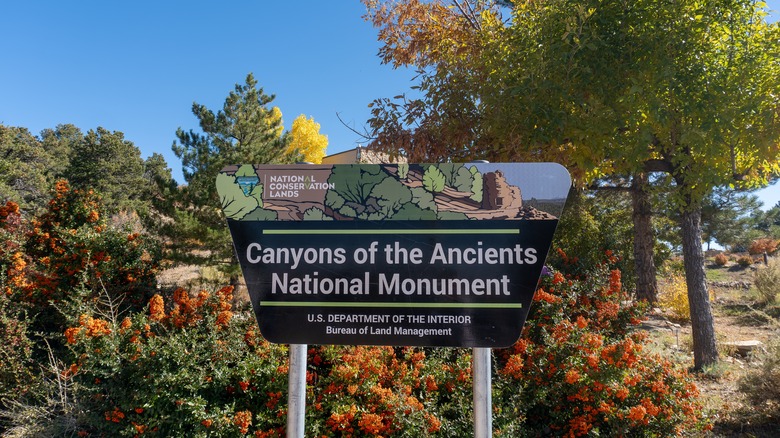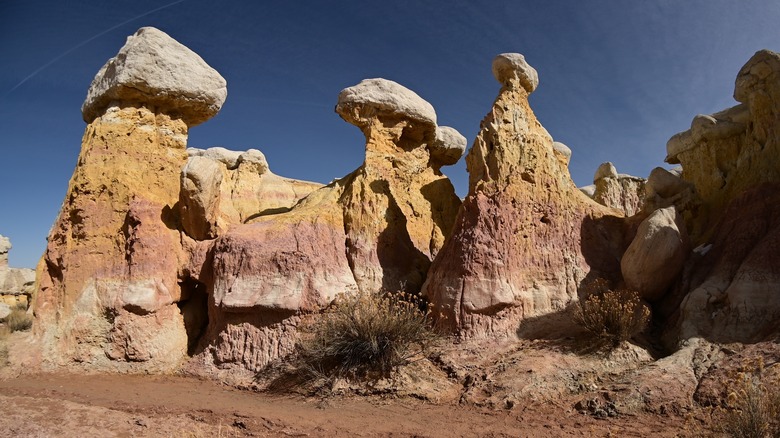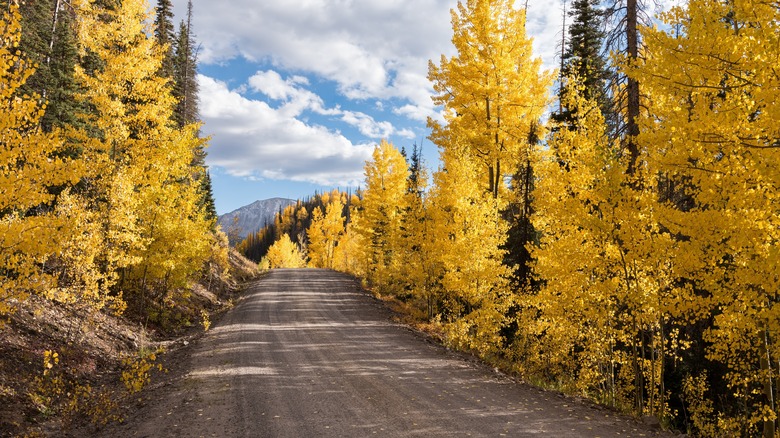The 5 Most Scenic National Forests And Monuments In Colorado You Can Visit For Free
Colorado is a beautiful state with plenty of locations perfect for hiking or skiing. However, many of the popular spots charge an entry fee. For example, Rocky Mountain National Park has some of the most popular and awe-inspiring hikes, but it requires a $30 entrance fee per vehicle and, in peak season, a timed reservation. Those costs can add up quickly if they weren't in your vacation budget. Thankfully, this isn't the only option for those wanting to see beautiful scenery or unique features found in Colorado. There are also plenty of forests and monuments all across the state, and many are completely free to explore.
The reduced cost does not mean they are lacking in beauty. The five locations below are not only free, but incredibly scenic, offering views and experiences you won't get anywhere else. These national forests and monuments are found all across the state, so you can visit one no matter where in Colorado you stay. Some are tucked away from the nearest hint of civilization while others are right in the heart of a city.
When you're ready to take in the scenery that makes so many fall in love with Colorado, pack up your car and head to one of these destinations. Just don't forget your phone or camera. You'll want to live in the moment while exploring these places, but you may regret it if you don't snap a couple of pictures during your adventure.
1. San Juan National Forest
San Juan National Forest is set between Durango and Telluride, which boasts front-row views of Colorado's Rocky Mountains. Despite its huge size, nearly 2 million acres, it is free to visit, camp in, and explore. With the correct permits, you can even go hunting. The forest is full of all different kinds of scenery to explore, including views from high above the tree line, the luscious edges of lakes, and even desert areas. Peaks, valleys, water features, forests, plains, and more stand ready to find in the San Juan Mountains, though a little searching is sometimes necessary.
With so much variety, it's impossible to describe San Juan National Forest as anything other than scenic and breathtaking. Though, if you were looking for another word, remote may be one that pops into your head after exploring some of the forest. The large expanse of remote wilderness leads one to feeling alone in the world, especially for those who venture off the beaten path.
If you're looking to see some incredible views, some of the most notable hikes the San Juans has to offer are the Ice Lakes Basin, Red Mountain Number 3, Engineer Mountain, Snowdon Peak, Columbine Lake, Yankee Boy Basin, Sneffels Highline Trail, and Macey Lakes. Despite its large size and popularity, the national forest and surrounding area is pretty underdeveloped, so if you're planning on visiting for a large portion of the day or even several days, make sure you pack anything you might need with you, including food and water, as there aren't places nearby to stop and grab a snack.
2. Garden of the Gods
Garden of the Gods is set in one of the most underrated vacation destinations in the United States — Colorado Springs. If you're looking for somewhere with stunning, one-of-a-kind views in the state that won't cost you a penny to explore, Garden of the Gods is definitely one of the places you have to visit. The park is full of towering formations, such as the Kissing Camels and Balanced Rock.
Despite being nestled in the city, it feels like an escape away from the urban environment. If you try some of the less popular trails, you may even find yourself alone and enjoying nature for a period of time. Hiking, biking, horseback riding, birding, and even rock climbing are allowed inside Garden of the Gods, so long as you take the time to review all of the rules and fill out proper permits where required.
In addition to the park itself being free, there is also a visitor center with amenities, open to the public at no charge. Inside the building is an award-winning gift store full of beautiful photography of the park and memorabilia. Purchases support the park. There are also informative exhibits showing the history of the unique rocks in the area and what led to their colors and shapes. On the side-facing entrance, an observation balcony allows for beautiful views and photos encompassing the whole park. The Gateway Cafe sells food and coffee, and the trading post offers more items to buy, including fudge and other delicious snacks.
3. Canyons of the Ancients National Monument
Canyons of the Ancients accounts for 174,000 acres controlled by the Bureau of Land Management in Colorado near Durango. The area is packed full of history, with remains from various Native American groups who once called the site home. Landmarks and artifacts remained relatively untouched throughout history. Structures such as shrines, fields, sweat lodges, and even entire villages remain here to visit. It's thought that the Canyons of the Ancients has been used for over 10,000 years.
Because it's owned by the Bureau of Land Management, there's not a lot of development, like campsites, but you can camp anywhere in the backcountry areas. However, there are guided tours available directly from the visitor center, and several third parties if you want to learn as much about the land and its history as possible. There is plenty to see and explore outside the tours as well, with over 6,000 different buildings in the area, amongst other natural scenery, farms, gathering areas, and pictographs. Some of the most popular spots in the monument include Lowery Pueblo, Painted Hand Pueblo, and Sand Canyon Pueblo.
One of the most underrated national parks in Colorado, Mesa Verde, is only a short drive away, though there is a cost for entry. If you can, it's worth it to visit both. But if you want a free and relatively uncrowded adventure, definitely check out Canyons of the Ancients. You are free to tour the area however you choose as long as you treat the archeological sites with the respect they deserve. Hike, bike, or take your horse with you when you explore this national monument.
4. Paint Mines Interpretive Park
The Paint Mines Interpretive Park does an excellent job of showcasing some of the variety in the state. The park is located near Calhan, Colorado, about 40 miles northeast of Colorado Springs. The Paint Mines earned its name because the indigenous people who inhabited the area would travel to the site to harvest its rich and colorful natural resources for paint. Evidence of people using the land dates back to around 9,000 years ago. In addition to taking advantage of the unusually-colored formations to create paint, the land's unique structure was also ideal for hunting. The clay is full of various bands of color, which appear due to oxidized iron compounds. The erosion led to exposed layers of stones like selenite and jasper, among others.
Now, the roughly 750 acres of breathtaking geological formations is free to visit. While climbing or scrambling on the various structures isn't allowed, people are encouraged to hike, take pictures, and enjoy a guided tour to learn more about the formations and their history. If you want to explore the area yourself, there is a 3.4-mile loop trail, which takes the average hiker a little under an hour and a half to explore. While you won't get as much background information about the area, you will still be able to see most of the impressive formations and designs.
5. Rio Grande National Forest
Rio Grande National Forest, first founded in 1908, is free for most visitors. It stretches over 1.8 million acres around the south-central part of Colorado, including parts of the San Luis Valley, South San Juan, La Garita, Sangre de Cristo, and Weminuche Wilderness areas. This forest is also home to the headwaters – or the place where the river starts – of the Rio Grande. Because of how this national forest stretches across the land, it's home to several kinds of natural features including lakes, deserts, thick forests of pine and juniper, river valleys, and mountain peaks, some of which reach over 14,000 feet.
With so much space and so many different natural features, it's no surprise that you can participate in almost any recreational activity you want to try. Camping, hiking, fishing, and hunting are just some of the ways you can get the most out of this free adventure-filled park. In the cooler months, there is usually more than enough snow to participate in winter sports like skiing. The average snowfall is over 400 inches a year in some areas of the forest. If you don't mind backcountry skiing, this can be a great way to participate in your favorite winter sports without having to spend a bunch of money visiting ski resorts and towns in Colorado like Aspen, the pretty city that is also the priciest vacation destination in the United States.
The forest is home to animals of all shapes and sizes, many you'll likely come across while exploring. Golden eagles, red-tailed hawks, pikas, elk, deer, boreal toads, cutthroat trout, and prairie dogs are just a few of the common species in the area. For those who prefer flora to fauna, the Rio Grande is also filled with various trees, flowers, and shrubs.
